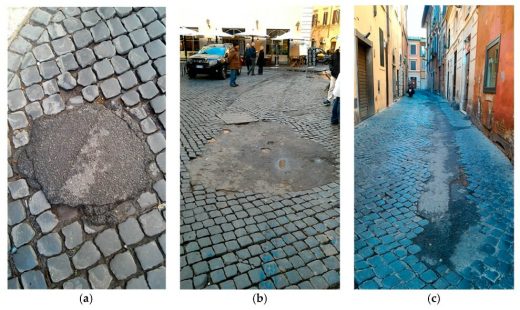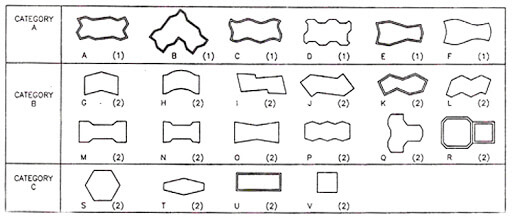Introduction
Interlocking Concrete Block Pavement (ICBP) has replaced the conventional concreting technique that required the use of traditional bricks and asphalt on the surface of the road. The traditional method was cumbersome as it required skill and accuracy to maintain the thickness of the road in addition to constant supervision by the site engineer. The roads had to be closed for hours as time was consumed in laying and mixing works. This problem was noticed by the higher authorities and the implementation of concrete blocks was recommended for ease of work.
The shape of such blocks varies as well as in size aspects because the design of these blocks constantly evolved during the years. The interlocking between the blocks was not good initially but as time went on, the design was modified so as to provide perfect interlocking. Interlocking is required to be perfect while laying as sand or other impurities might penetrate the gaps leaving the blocks isolated from the nearby blocks. This would result in breaking of the pattern and eventually the blocks would come out of the place. Hence, the works need to be precise on the field and is to be well monitored by the site engineers.

Fig 1: Laying of paver blocks
Courtesy: 2-10 Home Buyers Warranty
Benefits of such blocks
Such blocks provide more advantages compared to disadvantages. Some of which are listed below –
- These blocks are produced in factories in large quantities, so the dimensions can be made accurate as well as the production time is saved in the process.
- The better the quality of such blocks, the longer will be the life of the road. So, durability plays an important role in this aspect.
- Such blocks can sustain thermal expansion and contraction which is a big thumbs-up since the weather conditions like extreme cold or extreme hot have adverse effects on the pavements.
- Large deflections under structural load are much avoided in such blocks and so structural failure is not observed here, which is the opposite in the case of asphalt roads.
- Laying of such blocks does not require any skill. The importance is emphasised solely on the interlocking portion and maintaining the accuracy on laying.
- Time is saved here unlike in the case of asphalt roads where traffics had to be diverted since long hours were consumed in the process. Here, blocks are laid in no time which enables the traffic to pass within a few hours.
- Such blocks can be repaired very easily without any skills. If any blocks get detached from the surface then it can be repaired to the gap of the old block can be replaced by a new block without any hassle. It is very much more efficient than asphalt pavement in this aspect.
- Such blocks do not require much maintenance effort and is not affected by any type of fluid spilled on the road from passing vehicles like oil tankers or water tankers.
- Instead of using the paint on road for clear markings, coloured bricks can manufacture in the laboratory. This will reduce the cost of paint and other painting equipment that is required in asphalt roads.
- When heavy vehicles pass on these roads, the shear force, lateral force and punching force are generated on such pavements, which can cause breaking of the pavements. In such cases, concrete blocks are effective as they can take the impact and other such forces that can lead to disintegration of road sections.

Fig 2: Colourful paver blocks provided in lawn
Courtesy: iCloud Homes
Negative points
Apart from having so much benefit, it also has some disadvantages that discourage the use of such bricks to some extent. These are-
- Different works require different specifications and so such blocks cannot be used in this aspect as the property of such blocks cannot be changed much.
- If base course gets disturbed, then the whole laying process gets disturbed. This will lead to the shifting of the course of pavement which can prove fatal leading to road accidents.
- High quality sand and fillings are needed to fill the gaps as much as possible. Thus, the quality of such materials must not be neglected or compromised for maintaining the economy.
- Such blocks are not suitable for high-speed vehicles as such blocks also act as a speed breaker because of bumps in gaps. Thus, asphalt roads prove to be better here.
- If a granulated base course is laid below these concrete blocks, then there is a possibility of low drainage which can deteriorate the condition of the road.

Fig 3: Disintegration of paver blocks
Courtesy: MDPI
Shape and types
There are four types of concrete blocks that are used in pavements. They are-
- Type A: In this type, the blocks are with plain vertical faces. Here, the key is not required to be inserted between adjacent blocks when laying in any pattern.
- Type B: In this type, the blocks are with plain and corrugated vertical faces that are placed in alternate positions. Here, key is required to be inserted along the corrugated faces when laying in any pattern.
- Type C: In this type, the blocks are having all faces corrugated. Here, key is required to be inserted along all vertical faces when laying in any pattern.
- Type D: In this type, the blocks have ‘L’ and ‘X’ shaped which have all faces corrugated. Here is the key required to be inserted along all vertical faces when laying in any pattern.

Fig 4: Different shapes and dimensions of paver blocks
Courtesy: Pavers India
Conclusion
These blocks came into effect since their first application in Holland that proved to be successful in building a road which is durable and full of strength. Besides having disadvantages, such blocks are cheaper than the conventional road laying process and are beneficial for low to medium traffic. However, efforts are being made to change the specifications so that it is versatile in every aspect and all the disadvantages can be removed for more sophisticated applications in the construction industry. Indian Road Congress (IRC) has provided some standard specifications which are modified from time to time to meet the industry standards just like changes are being made in the building codes for coping up with the technological advancements. In the future, running of high-speed vehicles on such pavements can be expected if the surface is made smooth as much as possible, leaving no room for errors that will lead to the creation of bumps on roads. Furthermore, it is also advised that the site engineer keeps on updating their knowledge regarding such advancements so that the works can be completed in time less than the existing time period of implementation.
References
- NBM & CW, “Interlocking Concrete Paver Blocks”- https://www.nbmcw.com/tech-articles/concrete/4993-interlocking-concrete-paver-blocks
- Slideshare, “Interlocking Concrete Blocks Pavements”- https://www.slideshare.net/dileepr12/interlocking-concrete-blocks-pavements
If you have a query, you can ask a question here.


